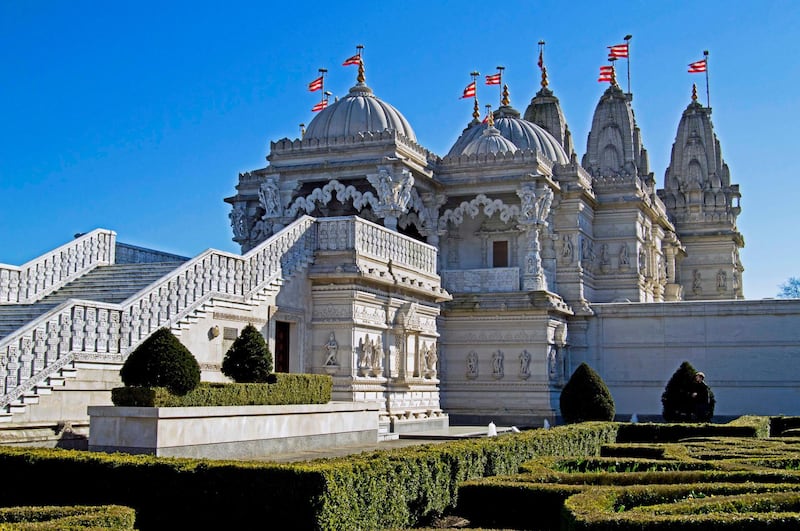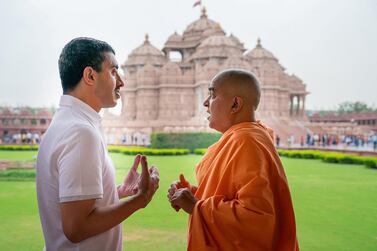Navdeep Suri, India's Ambassador to the UAE
There has been a longstanding need from the Indian community to have a religious premises where they can practise their beliefs. Currently there is a very, very small temple in Bur Dubai and the community has outgrown this. So this will be a major temple and open to all denominations and a place should reflect India’s diversity.
It fits so well into the UAE’s own commitment to tolerance and pluralism and coming in the year of tolerance gives it that extra dimension.
What we will see on April 20 is the foundation ceremony and we expect a pretty broad cross section of the Indian community to be present, both from the UAE and abroad. The Hindu group that is building the temple will have their holiest leader attending – and we expect very senior representation from the leadership of the UAE.
When the designs were taken to the leadership, there were two clear options. There was a New Jersey model with a rectangular structure with the temple recessed inside so it was not too visible from the outside and another was the Neasden temple in London with the spires in its classical shape. And they said: look we said we wanted a temple so it should look like a temple. So this should be a classical style temple in all its glory.
It is beautifully located - 30 minutes outside of Abu Dhabi and barely 45 minutes to Dubai so it serves the needs of both communities.
This is going to be the big temple where I expect people to come from across the country at major festivals and occasions.
It is hugely important – it will take a couple of years to complete given the scale. It is going to be remarkable and will contribute something not just to the landscape in terms of visual architecture but also to the ethos. Here will be a real representation of UAE’s pluralism.
Indian priests will chant ancient Vedic verses and offer prayers during a two-hour foundation stone ceremony for the first traditional Hindu temple in Abu Dhabi.
This will be part of the shilanyas or the foundation rites on April 20 to sanctify the pink sandstone that will be part of the base of the temple to be built in Abu Mureikha, near Al Rahba.
The sacred rituals will be conducted inside a large tent that will accommodate about 2,000 people from the UAE and overseas.
The sandstone to be used in the prayer ceremony will be transported to the UAE from India’s Rajasthan state next week.
About 50 sadhus or priests from India will conduct the prayer service to mark the preparation of the 10.9-hectare site for construction of a temple with arched domes and seven spires to represent each emirate.
“The foundation stones will reach UAE within the second week of April,” said a representative of Mandir Limited, which has been legally registered to build and administer the temple.
“The shilas (stones) for the foundation are being transported for the upcoming ceremony. The remaining stone will be shipped once they are sculpted in India. Construction will begin post this event, however, the date for construction has not been set as site facilities need to be established first.”
Sheikh Abdullah bin Zayed, Minister of Foreign Affairs and International Co-operation and Sheikh Nahyan bin Mubarak, Minister of Tolerance, will be present at the function along with Navdeep Suri, India's ambassador to the UAE.
The prayers will start early on April 20 and the area will be opened up at 2pm to the public who can make offerings of flowers at the site.
Prayer gatherings will be held in Jumeirah every morning for a week after the foundation stone ceremony and presided over by Mahant Swami Maharaj, the spiritual leader of BAPS.
In India, artisans have begun carving models of designs that will be replicated on the shrine’s pillars and columns.
"Procurement of pink stone has begun and sample carving work is currently underway. We anticipate the carving work to begin not too far after the shilanyas ceremony," the temple representative said.
Ornate hand carvings will bring to life messages of peace and tolerance from Indian scriptures to promote inter-faith harmony.
Craftsmen in India will etch the marble and stone panels with motifs of peacocks, trees, flowers, elephants for the structure that will later be assembled in Abu Dhabi.
Intricate architecture draws crowds to the temples run by the Baps Swaminarayan Sanstha, the religious and social organisation that has built shrines in India, the US, UK, Canada, Australia and Africa.
An elaborately etched peacock gate welcomes visitors to the expansive Akshardham temple in New Delhi. Figurines of musicians with classical instruments cluster around Hindu deities and saints nestled in the interior of some 1,200 temples run by the organisation worldwide.
Indian Prime Minister Narendra Modi revealed the temple structure last year during an address at the Dubai Opera. Mr Modi had announced the temple plan during his first visit as prime minister to the UAE in 2015.
The land for the temple was granted by Sheikh Mohamed bin Zayed, the Crown Prince of Abu Dhabi and Deputy Supreme Commander of the Armed Forces.
Navdeep Suri, India's Ambassador to the UAE
There has been a longstanding need from the Indian community to have a religious premises where they can practise their beliefs. Currently there is a very, very small temple in Bur Dubai and the community has outgrown this. So this will be a major temple and open to all denominations and a place should reflect India’s diversity.
It fits so well into the UAE’s own commitment to tolerance and pluralism and coming in the year of tolerance gives it that extra dimension.
What we will see on April 20 is the foundation ceremony and we expect a pretty broad cross section of the Indian community to be present, both from the UAE and abroad. The Hindu group that is building the temple will have their holiest leader attending – and we expect very senior representation from the leadership of the UAE.
When the designs were taken to the leadership, there were two clear options. There was a New Jersey model with a rectangular structure with the temple recessed inside so it was not too visible from the outside and another was the Neasden temple in London with the spires in its classical shape. And they said: look we said we wanted a temple so it should look like a temple. So this should be a classical style temple in all its glory.
It is beautifully located - 30 minutes outside of Abu Dhabi and barely 45 minutes to Dubai so it serves the needs of both communities.
This is going to be the big temple where I expect people to come from across the country at major festivals and occasions.
It is hugely important – it will take a couple of years to complete given the scale. It is going to be remarkable and will contribute something not just to the landscape in terms of visual architecture but also to the ethos. Here will be a real representation of UAE’s pluralism.







